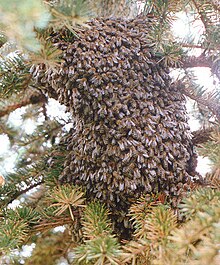Bees

The bee is a historically developed term for the superorganism of the bee colony in which honeybees live in community, i.e. all animals in a beehive. This community has developed skills that the individual bee cannot master. For example, although it as an insect -blooded animals , they can keep the temperature permanently as a warm-blooded animal in the group. This community is called state, people or family and is organized differently.
In the 20th century, the term superorganism was introduced for the developed communities of ants and bees. The bee community is made up of individual organisms and uses signal substances to coordinate their activities, comparable to an organism. Individual bees and specialized groups can only survive as a whole.
The beekeeper Johannes Mehring (1815–1878) compared the bees with a vertebrate. As examples: the queen is the female and the drones are the male sex organ. The worker bees are the digestive tools. For him, the one being was more than the sum of its parts, it was a closed system of bees, honeycombs and stores.
The beekeeper Ferdinand Gerstung (1860–1925) developed the concept of the "Bien organism" based on Mehring's ideas. In his opinion, this consists of organs such as plant and animal organisms. Since the organs of the bee do not come from an egg and are not fused together like those of other organisms, he called for the definition of the term organism to be expanded. It was clear to him that the concept of organism did not completely fit the bees, but he did not find a more suitable one.
See also
literature
- Johannes Mehring: The new system of bees as a basis for beekeeping or How the rational beekeeper achieves the highest yield from his bees. Based on self-experience. Frankenthal, Albeck 1869. 344 pp.
- Johannes Mehring: The new one-being system as the basis for beekeeping. Based on self-experience. Theoretical part re-edited by Ferdinand Gerstung. Waetzel, Freiburg i. B. 1901. 68 pp.
- Ferdinand Gerstung: The bees and their breeding. Fritz Pfenningstorff Berlin. A total of seven editions - the last in 1926.
- August Ludwig: Our bees. A detailed handbook of apiculture and beekeeping. Fritz Pfenningstorff Berlin. A total of four editions - the last in 1937.
- Robin FA Moritz & Edward E. Southwick: Bees As Superorganisms. Evolutionary Reality. Springer-Verlag 1992. In English. ISBN 0-387-54821-1 .
- Jürgen Tautz & Helga R. Heilmann: The honeybee phenomenon. Spectrum Akademischer Verlag 2007. ISBN 3-8274-1845-3 .
- Jürgen Tautz: The Bien. Honey bee superorganism. Audio book. suppose 2007. ISBN 3-932513-80-0 .
- Jürgen Tautz: The Bien - a mammal with many bodies. Bee colony superorganism. in Biology in Our Time, Vol. 38, 1/2008, pp. 22-29.
- Heinrich Sannemann: The bee and its true task on earth. ISBN 3-927950-05-X .
- The bees and their breeding . Reprint of the last edition from 1926. Buschhausen, Herten 2019. ISBN 978-3-946030-51-5 .